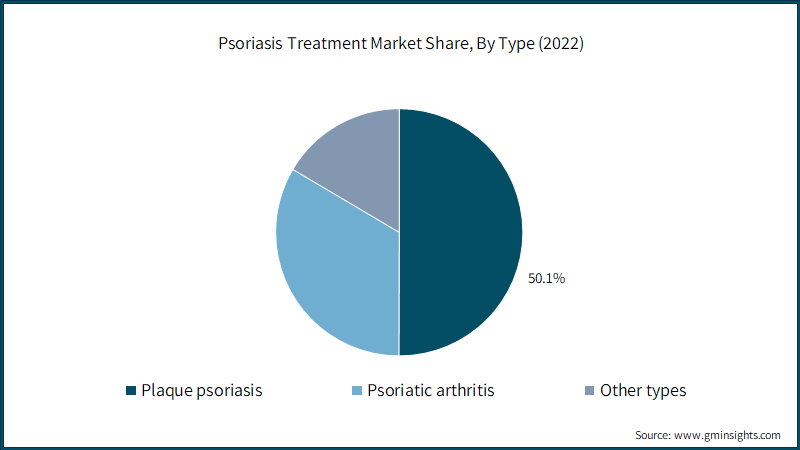Home > Healthcare > Pharmaceuticals > Disease Specific Drugs > Psoriasis Treatment Market
Psoriasis Treatment Market Analysis
- Report ID: GMI6129
- Published Date: Jun 2023
- Report Format: PDF
Psoriasis Treatment Market Analysis
Based on drug class, the psoriasis treatment market is segmented as TNF inhibitors, interleukins inhibitors, vitamin D analogs, and other drug classes. The interleukins inhibitors segment accounted for the largest share of 46.6% in 2022. Interleukin inhibitors have demonstrated significant success in the treatment of psoriasis. They directly target the inflammatory processes associated with the development and progression of psoriasis, resulting in considerable clinical relief and better skin clearing. Clinical trials have shown that they can provide immediate and persistent responses, making them a viable therapy choice for people with moderate to severe psoriasis.
Furthermore, interleukin inhibitors provide an important treatment option for patients who have not responded adequately to traditional therapies such as topical creams, phototherapy, or conventional systemic medications. For individuals with moderate to severe psoriasis who do not achieve satisfactory results with standard treatments, interleukin inhibitors offer a new and effective approach to disease management.

Based on type, the psoriasis treatment market is segmented as psoriatic arthritis, plaque psoriasis, and other types. The plaque psoriasis segment held dominant market share of around 50.1% in 2022 and is expected to grow at a significant pace of 8.5% by 2032. Plaque psoriasis is the most common type of psoriasis, affecting a large proportion of the world's population.
However, despite the availability of many therapeutic options, there are still unmet medical requirements in plaque psoriasis care. Certain therapies may cause insufficient response, intolerance, or contraindications in some individuals. There is an ongoing effort towards developing novel medicines and treatment methods that provide greater efficacy, safety, and long-term results for people with plaque psoriasis.
Based on route of administration, the psoriasis treatment market is segmented parenteral, topical, and oral. The parenteral segment was anticipated to be worth USD 21.8 billion in 2022 and is expected to grow at 8.6% CAGR by 2032. Most drugs used for the treatment of psoriasis are available in subcutaneous injections and intravenous infusions. Parenteral administration allows for quick and direct delivery of the medication into the bloodstream. This results in a rapid onset of action, enabling faster relief of symptoms and potentially more immediate therapeutic effects. Moreover, parenteral administration allows for precise dosing and control over the amount of medication administered. This is particularly important in the case of potent psoriasis treatment drugs where accurate dosing is critical for achieving optimal therapeutic outcomes and minimizing the risk of adverse effects.
Based on distribution channel, the psoriasis treatment market is segmented as hospital pharmacies, retail pharmacies, and other distribution channels. The hospital pharmacies segment held a dominant market share of 64.8% in 2022 and is expected to grow at a CAGR of 8.4% by 2032. Hospital pharmacies frequently have access to specialised drugs and therapies that may not be easily available in other healthcare settings. This is especially crucial for those who have severe or resistant psoriasis and require advanced therapy. Biologic drugs, immunomodulators, and other targeted medicines that require specialised handling and administration can be obtained and provided by pharmacies in hospitals.

North America psoriasis treatment market is expected to reach USD 25 billion in 2032 with a CAGR of 8.5% by 2032. North America has a well-developed and advanced healthcare infrastructure, including hospitals, clinics, research institutions, and pharmaceutical companies. This infrastructure supports the diagnosis, treatment, and management of psoriasis, facilitating the availability of a wide range of treatment options and promoting innovation in the field.
Moreover, the region's robust R&D activities in the field of psoriasis contribute to advancements in treatment options. Academic institutions, research organizations, and pharmaceutical companies in North America conduct extensive research to understand the underlying mechanisms of psoriasis, develop novel therapies, and improve existing treatment approaches.

